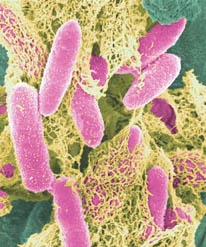Team:Wageningen UR/Safety/One
From 2011.igem.org
(→Safety) |
|||
| Line 36: | Line 36: | ||
====== '' A. nidulans '' ====== | ====== '' A. nidulans '' ====== | ||
| - | The filamentous fungus ''Aspergillus nidulans'' (strain pyrG89 argB2 pabaB22 nkuATargB riboB2, ordered from FGSC; A1147) is capable of producing spores. Though the route of infection should be effective, according to Kim et al., disease caused by the micro-organsim is rarely seen in healthy persons (1997 Jun; [ | + | The filamentous fungus ''Aspergillus nidulans'' (strain pyrG89 argB2 pabaB22 nkuATargB riboB2, ordered from FGSC; A1147) is capable of producing spores. Though the route of infection should be effective, according to Kim et al., disease caused by the micro-organsim is rarely seen in healthy persons (1997 Jun; [https://2011.igem.org/Team:Wageningen_UR/Safety/Nine Jump to references]). Correspondingly, the Dutch ‘Regeling Genetisch Gemodificeerde Organismen' (Regulation of Genetically Modified Organisms) classified ''A. nidulans'' as Biosafety level (BSL) 1 and allows genetical modifications when it's performed in a ML-II lab. |
Project developments may require work with ''Aspergillus niger'' in addition to ''A. nidulans''. This micro-organism is also classified as BSL 1 and is therefore subject to the same safety considerations as ''A. nidulans''. | Project developments may require work with ''Aspergillus niger'' in addition to ''A. nidulans''. This micro-organism is also classified as BSL 1 and is therefore subject to the same safety considerations as ''A. nidulans''. | ||
| Line 48: | Line 48: | ||
====== '' E. coli '' ====== | ====== '' E. coli '' ====== | ||
| - | The ''Escherichia coli'' TOP10 strain used in this project is a derivative of the non-pathogenic K-12 laboratory strain. The likelihood of a human becoming infected is therefore low. The most probable route of transmission would occur by accidental ingestion, though the bacterium’s inability to be retained in the human gut decreases the chance of it to develop disease in humans (EPA, 2011; [ | + | The ''Escherichia coli'' TOP10 strain used in this project is a derivative of the non-pathogenic K-12 laboratory strain. The likelihood of a human becoming infected is therefore low. The most probable route of transmission would occur by accidental ingestion, though the bacterium’s inability to be retained in the human gut decreases the chance of it to develop disease in humans (EPA, 2011; [https://2011.igem.org/Team:Wageningen_UR/Safety/Nine Jump to references]). Mainly for these reasons, this organism is also classified as BSL 1. |
Revision as of 09:32, 23 August 2011
 "
"




